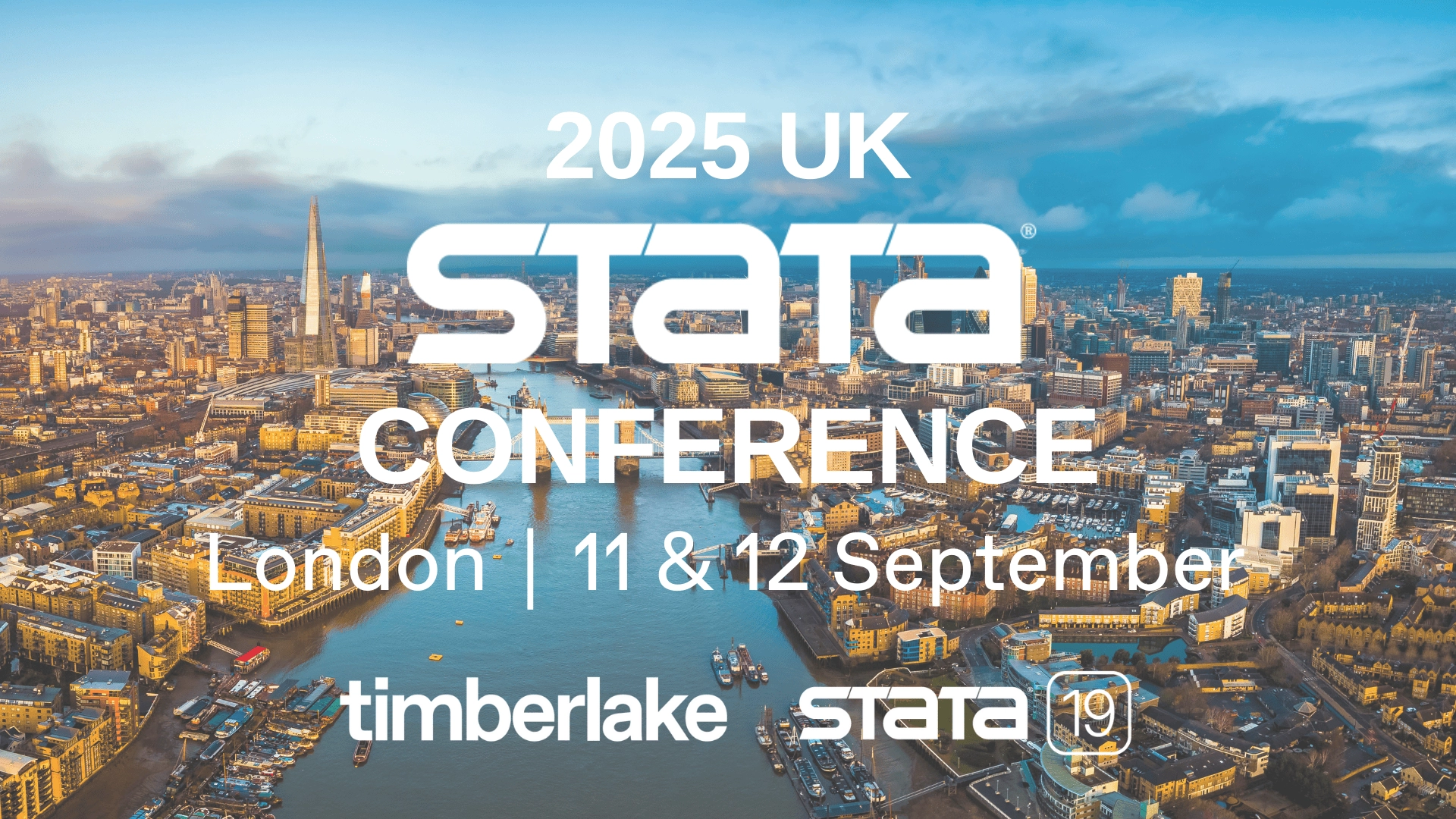
Enrol Here
- –
- 2 jours
- University of Westminster, London
Data visualisation is a critical step in the research workflow, yet it is often underutilised or misapplied. Based on the newly released Graphs Everyone Should Know and How to Create Them in Stata (Stata Press), this two-day course looks closer at the art of visualising data. By focusing on practical examples, participants will learn best practices for creating clear, insightful graphs, ranging from simple univariate distributions to advanced animated graphs and model-based visualisations.
By the end of the course, participants will understand how to:
- Identify the most appropriate graph type for different data structures (univariate, bivariate, or multivariate).
- Create a wide variety of plots (including histograms, box plots, scatterplots and heat plots) in Stata using both built-in and community-contributed commands.
- Tailor essential graph options (labels, scales, overlays) without getting overwhelmed by every possible customisation.
- Incorporate more advanced or novel graph types, such as animations, maps, coefficient plots, and 3D surface plots, into their workflow.


Course Structure
Day 1: Univariate & Bivariate
Topics Include:
Morning session (10am to 12.30pm)
- Introduction to graphs in Stata
- Graphs for Univariate
- Hands on Exercise (Generating Univariate Plots in Stata)
Afternoon session (1.30pm to 4.30pm)
- Bivariate Data Visualisation
- Lines of Fit, Nonparametric Smoothers, and Bivariate Charts.
- Hands on Exercise (Generating Bivariate Plots in Stata)
Wrapping Up for the Day (1.30pm to 4.30pm)
Day 2: Multivariate & Specialised Visualisation
Topics Include:
Morning session (10am to 12.30pm)
- Multivariate Data Visualisation
- Contour and Trivariate Heat Plots
- Bubbles Plots
- 3D Scatterplots
- Hands on Exercise (Generating correlation matrices, bubble plots & 3D visuals)
Afternoon session (1.30pm to 4.30pm)
- Specialised Advanced Graphs
- Hands on Exercise (Advanced automated plotting)
Final Q&A with Open Discussion (4.30pm to 5.00pm)
Learning Outcomes
By the end of this two-day course, participants will be able to:
- Identify the most effective graphical method to visualise univariate, bivariate, and multivariate data in Stata.
- Confidently use Stata’s built-in and community-contributed graph commands, customising essential elements like labelling, colouring, and overlays.
- Interpret and present complex results with clarity.
- Automate repetitive tasks using do-files for reproducible research.
Who Should Attend
- Researchers and graduate students looking to polish the graphical presentation of their data.
- Analysts in government, finance, healthcare, or any field that requires high-quality visualisation.
- Anyone seeking to expand beyond basic bar charts and scatterplots to gain deeper insights from their data.
Prerequisites
- Basic knowledge of data analysis
- Basic knowledge of Stata is an advantage but not essential.
- No previous experience with specialised visualisation techniques is required.
- But basic familiarity with is conducive with an enjoyable learning experience.
Day 1
Morning Session (10:00 – 12:30)
Introduction to Graphs in Stata
- Overview of Stata’s graph capabilities.
- Navigating essential Stata commands and syntax for plotting, including the command graph.
- Understanding the Stata Graph Editor.
Graphs for Univariate Data
- Histograms and kernel density plots: understanding distributions.
- Box plots and violin plots: spotting outliers and distribution shape.
- Dot plots and stem-and-leaf plots: alternative ways to depict univariate distributions.
- Βar charts, pie charts, and radar charts: visualising categories and proportions.
Hands-On Exercise
- Generate key univariate plots in Stata using training datasets.
- Exploring custom bin widths, multiple overlays, and labelling best practices.
Afternoon Session (13:30 – 16:00)
Bivariate Data Visualization
- Scatterplots: analyse variables jointly, layer data points and group by categories.
- Heat plots, hex-plots, and binned scatter plots: reveal dense clusters of data.
- Line plots and area plots: visualise trends and ranges.
- Lines of best fit, polynomial fits, and nonparametric smoothers: understand bivariate relationships and fits
- Bivariate bar charts, stacked bar charts and table plots: graphs for analysing frequencies, percentages and categories.
Hands-On Exercise
- Practice creating bivariate plots with various layering and labelling.
- Experiment with overlays of fitted lines and confidence intervals.
Wrapping Up the First Day (16:00 - 16:30)
- Key takeaways for univariate and bivariate visualisation.
- Q&A session and practical troubleshooting.
Day 2
Morning Session (10:00 – 12:30)
Multivariate Data Visualization
- Matrix plots and trellis plots: exploring multiple variables simultaneously.
- Contour plots and trivariate heat plots: using colour to visualise a third dimension
- Bubble plots, Chernoff faces, and triplots: creative ways to show multiple dimensions.
- 3D scatterplots and 3D surface plots: how to use basic 3D graphs in Stata.
Hands-On Exercises
- Working with sample datasets to create correlation matrices, bubble plots, and 3D visuals.
- Group discussion on identifying the best graph to convey research findings.
Afternoon Session (13:30 – 16:30)
Specialised and Advanced Graphs
- Animated graphs: creating gifs or videos for time-lapse or progression data.
- Rainbow plots: colour-coded series to highlight patterns over time.
- Plotting regression results: visualising model coefficients, interaction effects, and predictions.
- Plotting equations: quick ways to visualise functional relationships.
Hands-On Exercises
- Building a short do-file to automate advanced plots.
Final Q&A & Discussion (16:30 - 17:00)
- Tips for exporting and embedding graphics in reports or presentations.
- Course review and further resources.
- Additional questions and advanced troubleshooting.
Course Timetable
Terms
- Student registrations: Attendees must provide proof of full time student status at the time of booking to qualify for student registration rate (valid student ID card or authorised letter of enrolment).
- Additional discounts are available for multiple registrations.
- Delegates are provided with temporary licences for the principal software package(s) used in the delivery of the course. It is essential that these temporary training licenses are installed on your computers prior to the start of the course.
- Payment of course fees required prior to the course start date.
Cancellations
- 100% fee returned for cancellations made over 28-calendar days prior to start of the course.
- 50% fee returned for cancellations made 14-calendar days prior to the start of the course.
- No fee returned for cancellations made less than 14-calendar days prior to the start of the course.
The number of attendees is restricted. Please register early to guarantee your place.




Validate your login
Se connecter
Créer un nouveau compte